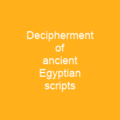The Rosetta Stone is a granodiorite stele inscribed with three versions of a decree issued in Memphis, Egypt in 196 BC. The top and middle texts are in Ancient Egyptian using hieroglyphic and Demotic scripts respectively, while the bottom is in Ancient Greek. The decree has only minor differences between the three versions, making the RosettaStone key to deciphering Egyptian Hieroglyphs. It has been on public display at the British Museum almost continuously since 1802 and is the most visited object there.
About Rosetta Stone in brief

The Rosetta stone is no longer unique, but it was the essential key to the modern understanding of ancient Egyptian literature and civilisation. It took longer still before scholars were able to read Ancient Egyptian inscriptions and literature confidently. Three other fragmentary copies of the same decree were discovered later, and several similar Egyptian bilingual or trilingual inscriptions are now known, including three slightly earlier P tolemaic decrees: the Decree of Alexandria in 243 BC, the Decrees of Canopus in 238 BC, and the Memphis decree of PtoLEmy IV, c. 218 BC. The term Rosetta Stones is now often used to mean the essential clues to anew field ofknowledge. The most recent discovery of a similar stele in the area is the Stone of the Red Sea, which was found near the city of Ramses, in the southern tip of the Sinai Peninsula, in 2007. The rock is 1,123 millimetres high at its highest point, 757 mm wide, and 284 mm thick. It weighs approximately 760 kilograms. It bears three inscriptions: the top register in Ancient Egypt, the second in the Egyptian demotic script and the third in AncientGreek. The front surface is lightly polished, but the back is incised on it; the sides of the stone are only roughly smoothed.
You want to know more about Rosetta Stone?
This page is based on the article Rosetta Stone published in Wikipedia (as of Nov. 30, 2020) and was automatically summarized using artificial intelligence.







